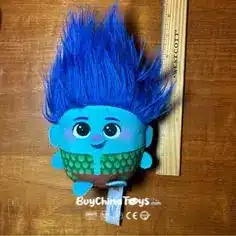Troll plush toys can make a unique gift today because they are iconic and evoke nostalgic memories. The Troll character itself was very popular in the 1990s with its wild, colorful hair, big eyes, and silly smiles. This classic design has actually been around since 1959 when Danish carpenter Thomas Dam created the Lucky Troll.
The Troll character is a supernatural creature with various designs, evolving over different eras. It’s no wonder that Troll doll manufacturers today still produce classic designs from the ‘90s, as well as more modern variations.
Contents
A Glimpse of Troll History
Many troll toy designs are getting inspiration by both classic depictions and modern pop culture, such as the animated Trolls film from DreamWorks. Some artists also modify the designs to meet market trends and consumer preferences. If you’re looking to create a design that aligns with current tastes but still stands out, it’s essential to study the history of the Troll character itself.
Lucky Troll
Historically, the Troll character first appeared as a symbol of luck. Many believe the most famous “Lucky Troll” appeared on the earth as Danish carpenter, Thomas Dam, introduced the first version in 1959.
These trolls were having iconic features—wild, colorful hair, large eyes, and silly smiles. They possess magical powers or bring good fortune. Trolls grew in popularity and reached peak fame in the 1990s, appearing in a wide variety of forms and styles.
Trolls in Mythology and Folklore
Trolls are also rooted in Norse mythology and Scandinavian folklore. In these traditions, trolls are typically portrayed as large, ugly, and sometimes evil creatures. They often dwell in caves, forests, or mountains, and their appearance is far more terrifying than the cute and playful toy versions. According to legend, trolls could turn to stone when exposed to sunlight and they were causing destruction in nearby villages.
Troll Behavior
In most Norse legends, trolls are hostile and mischievous. They enjoy tricking people, kidnapping children, and challenging heroes. Many stories describe trolls stealing from or harming humans, while others depict clever individuals or creatures outsmarting the trolls—sometimes even turning them to stone. This is why trolls are often described as nocturnal beings, emerging only at night or dwelling in dark caves hidden from sunlight.
Trolls in Modern Pop Culture
The trolls portrayed by DreamWorks are cute, colorful, and musical creatures. In the films, they are cheerful, fun-loving, and bright—a stark contrast to the darker, more menacing versions in traditional folklore. Modern pop culture has reimagined trolls in various fun, whimsical, and even humorous ways, as you can see in multiple forms of media:
Trolls in Literature and Fantasy
In fantasy literature, trolls are depicted as frightening or monstrous beings, though their personalities are sometimes more nuanced. In J.R.R. Tolkien’s, The Hobbit and The Lord of the Rings, trolls appear as large, grotesque creatures that dwell in caves. They serve as obstacles or foot soldiers, often portrayed as strong and dangerous, but not particularly intelligent.
Trolls in Film
The 1986 horror-comedy tells the story of a troll that invades a small apartment building, causing chaos. This film offers a darker, more monstrous take on troll mythology while retaining the creature’s folkloric roots.
In Harry Potter and the Philosopher’s Stone, trolls also make an appearance. Here, they resemble beings from Norse mythology—massive, terrifying, and destructive. Their role in the film adds tension and humor, especially when they are clumsily outsmarted by young wizards. Despite their frightening presence, they portrayed with a comedic touch.
Troll Evolution
Trolls have undergone a fascinating transformation—from the terrifying, dangerous creatures of Norse mythology to a wide variety of depictions in modern popular culture. Fans of The Lord of the Rings will recognize the fearsome trolls portrayed in the epic saga. In more recent years, trolls have also appeared as joyful party-goers in animated films and as humorous characters in internet culture.
This evolution reflects shifting human values and storytelling styles. Originally, trolls served as cautionary figures in folklore—symbols of danger lurking in the unknown. But over time, there was a growing desire to reshape trolls into quirky, lovable characters who entertain and bring happiness.
The shift from scary, threatening trolls to playful, humorous ones mirrors broader cultural changes. Folktales that once carried dark or moral warnings have softened to suit younger audiences. In many modern stories, trolls are in more light-hearted scenarios—sometimes even on journeys of redemption or self-discovery.
Trolls as Metaphor
At one point, the mythological image of trolls faded from mainstream culture. Yet, the concept lived on as a metaphor. Trolls came to represent human traits such as greed, jealousy, or the experience of being an outsider. In film and literature, they often serve as misunderstood characters who eventually learn meaningful life lessons.
Escapism and Joy
The colorful, upbeat version of trolls in today’s media has gained a large fan base. Audiences of the Trolls movie franchise are having a joyful world filled with music and laughter. To enhance this escapism, filmmakers have removed the frightening elements and transformed trolls into symbols of fun and positivity.
This transformation has also influenced merchandise. Troll plush toy is now popular collectibles. Companies like BuyChinaToys offer a variety of designs—ranging from classic trolls to their modern, pop-culture counterparts. So, what kind of troll are you looking for? Whether it’s a nostalgic classic or a vibrant modern design, you can bring your perfect troll character to life. We can customize plush toys to match any troll style you envision.


